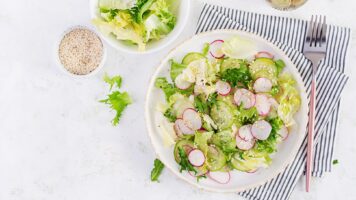In the hottest months of the year, the body asks us for food which hydrates and refreshes us. Normally, they tend to be those foods that are more palatable and rich in sugars and poor quality fats. If, in addition, we combine it with messy schedules and daily logistics that are a little bit different from the usual, it can be somewhat complicated to manage the low-histamine diet during the summer.
In our society, the idea of taking care of yourself especially in the months before summer is deeply rooted, on account of miracle and weight-loss diets that promise magical results to show off a dream body. Due to the fact that these types of practices are neither healthy nor sustainable over time, when the halfway point of summer arrives, food is usually neglected, falling into improvisation and resorting to less healthy foods. On the other hand, these months of the year are full of events, celebrations, holidays… and this fact, by itself, lead us to follow a diet that is quite different from the usual. This set of factors must help us reflect and change the way we see and understand health: we need to take care of it throughout the year and, furthermore, pay special attention if there is any type of digestive disorder, as is the case with DAO deficiency.
As nutrition professionals, we ensure that patients learn to correctly follow the low-histamine diet and, above all, the nutritional recommendations that accompany it, in order to improve their quality of life throughout the year. For this reason, at AD Dietistas we help customize the patient’s low-histamine diet, taking into account all the factors that influence him. Consequently, following the designed pattern will be much more familiar and easier to follow. On the other hand, it is important for the patient to plan, since establishing a specific time of the week to make the shopping list, go shopping and cook will be our great ally. Perhaps, it may seem somewhat complicated to become this idea into a reality or, on the contrary, this fact may be downplayed; however, falling into improvisation will play against our objective, especially at the beginning of diagnosis and treatment. In this sense, having a good organization will be key to being able to make the low-histamine diet not be an obstacle during the holidays. In addition, as this planning and organization are putting into practice, it is going to become a new habit that will accompany us forever.
It will be important to try that in each main meal there is a plate of vegetables or salad (green beans, carrots, lettuce, radishes, peppers, beets…). In addition, we must not forget to combine this first with a second dish of fish, meat, egg yolks or legumes (hake, cod, chicken, lentils, chickpeas…) and some cereal or tuber (potato, rice, pasta…) in moderation. As for the sauces, we must ensure that they are low in histamine. Prioritizing water as the drink and avoiding carbonated and alcoholic beverages will always be the best option. However, other ideas that we could also include would be fruit smoothies without added sugars or cold infusions, for example. Desserts can be healthy without giving up their appeal. A fruit salad, a sorbet or a fruit skewer (watermelon, melon, peach, apricot, cherries, raspberries…) can be a fantastic option. Finally, with regard to cooking, it is always better to prioritize those that are softer, such as grilled, baked, boiled or steamed.
It should be noted that it will be essential to know in what phase of the low-histamine diet we are in, in order to plan and organize what foods we can include in our menus or what we can choose in a restaurant. Thus, summer should not be an obstacle to being able to continue with our dietary pattern.
If you want us to advise you in a personalized way, either in our Barcelona nutrition centre or by video conference from anywhere in the world, contact us and we will help you



